Connected Vehicle Technology for Improved Multimodal Winter Travel: Agency Perspective and a Conceptual Exploration
Abstract
1. Introduction
2. Literature Review
2.1. CV Applications for Winter Road Weather Management
2.2. CV Applications for Multimodal Travel
3. National Survey of Transit Agencies
4. CV Application for Multimodal Winter Travel
4.1. Concept Description of CV Applications for Multimodal Travel
4.2. Subsystems and Communication Technologies for the Proposed CV Application Framework
4.2.1. Data Collection
4.2.2. Data Processing
4.2.3. Data Distribution
4.2.4. Communication Technologies
4.3. Uniqueness of the Proposed Conceptual Framework
4.4. Operational Assumptions and Constraints
4.5. Advantages and Limitations of CV Technology Application Framework in Multimodal Winter Travel
4.5.1. Advantages
4.5.2. Limitations
5. Conclusions
Author Contributions
Funding
Acknowledgments
Conflicts of Interest
References
- Snow & Ice. Available online: https://ops.fhwa.dot.gov/weather/weather_events/snow_ice.htm (accessed on 28 January 2018).
- How Do Weather Events Impact Roads? Available online: https://ops.fhwa.dot.gov/weather/q1_roadimpact.htm (accessed on 19 November 2018).
- Andersson, A.K. Winter Road Conditions and Traffic Accidents in Sweden and UK. Ph.D. Thesis, University of Gothenburg, Gothenburg, Sweden, 2010. [Google Scholar]
- Saha, S.; Schramm, P.; Nolan, A.; Hess, J. Adverse weather conditions and fatal motor vehicle crashes in the United States, 1994–2012. Environ. Health 2016, 15, 104. [Google Scholar] [CrossRef] [PubMed]
- Dey, K.C.; Mishra, A.; Chowdhury, M. Potential of intelligent transportation systems in mitigating adverse weather impacts on road mobility: A review. IEEE Trans. Intell. Transp. Syst. 2015, 16, 1107–1119. [Google Scholar] [CrossRef]
- Pisano, P.A.; Goodwin, L.C.; Rossetti, M.A. US Highway Crashes in Adverse Road Weather Conditions; U.S. Department of Transportation: New Orleans, LA, USA, 2008.
- U.S. DOT (United States Department of Transportation). Connected Vehicle-Enabled Weather Responsive Traffic Management; Report no FHWA-JPO-18-648; U.S. Department of Transportation: New Orleans, LA, USA, 2018.
- Sukuvaara, T.; Nurmi, P. Connected vehicle safety network and road weather forecasting–the WiSafeCar project. In Proceedings of the SIRWEC 2012, 16th International Road Weather Conference, Helsinki, Finland, 23–25 May 2012; pp. 23–25. [Google Scholar]
- Architecture Reference for Cooperative and Intelligent Transportation. Available online: https://local.iteris.com/arc-it/ (accessed on 3 March 2020).
- Drobot, S.; Chapman, M.; Schuler, E.; Wiener, G.; Mahoney, W., III; Pisano, P.; McKeever, B. Improving road weather hazard products with vehicle probe data: Vehicle data translator quality-checking procedures. Transp. Res. Rec. J. Transp. Res. Board 2010, 128–140. [Google Scholar] [CrossRef]
- Shi, X.; O’Keefe, K.; Wang, S.; Strong, C. Evaluation of Utah Department of Transportation’s Weather Operations/RWIS Program: Phase I; Utah Department of Transportation: Taylorsville, UT, USA, 2007.
- Nordin, L.; Riehm, M.; Gustavsson, T.; Bogren, J. Road surface wetness variations: Measurements and effects for winter road maintenance. J. Transp. Eng 2013, 139, 787–796. [Google Scholar] [CrossRef]
- Hill, C.J. Concept of Operations for Road Weather Connected Vehicle Applications; FHWA: Washington, DC, USA, 2013.
- Robinson, R.; Cook, S.J. Slippery Road Detection and Evaluation; Michigan Department of Transportation Research Administration: Ann Arbor, MI, USA, 2012.
- Hirt, B.; Petersen, S. Installing Snowplow Cameras and Integrating Images into MnDOT’s Traveler Information System; Minnesota Department of Transportation, Research Services & Library: St Paul, MN, USA, 2017. [Google Scholar]
- Belzowski, B.M.; Cook, S.J. The Connected Driver: Integrated Mobile Observations 2.0 (IMO 2.0); University of Michigan Transportation Research Institute: Ann Arbor, MI, USA, 2016. [Google Scholar]
- Linton, M.A.; Fu, L. Connected vehicle solution for winter road surface condition monitoring. Transp. Res. Rec. 2016, 2551, 62–72. [Google Scholar] [CrossRef]
- Li, H.; Peters, L.; Banuelos, C.; Zaugg, J.; Sharma, A.; Bullock, D.M. Leveraging snowplow dashboards cams and connected vehicle speed data to improve winter operations performance measures. JTRP 2019. [CrossRef]
- Alfelor, R.M.; Pisano, P.A.; Galarus, D.; Yohanan, D. Using Clarus data for disseminating winter road weather advisories and other weather-related alerts. In Proceedings of the International Conference on Winter Maintenance and Surface Transportation Weather, Coralville, IA, USA, 30 April–3 May 2012; pp. 223–236. [Google Scholar]
- Schneeberger, J.D.; Torng, G.W.; Hardesty, D.; Jacobi, A. Transit Vehicle Collision Characteristics for Connected Vehicle Applications Research: Analysis of Collisions Involving Transit Vehicles and Applicability of Connected Vehicle Solutions; ITS-Joint Program Office: Washington, DC, USA, 2013.
- Pierce, B.; Zimmer, R. Transit Bus Stop Pedestrian Warning Application: Concept of Operations; Federal Transit Administration: Washington, DC, USA, 2015.
- English, T.; Serulle, N.U.; Stephens, D.; Gopalakrishna, D.; Garcia, V.; Ostroff, R. Connected Vehicle Pilot Deployment Program Phase 2, System Architecture Document-WYDOT CV Pilot; Report no. FHWA-JPO-17-467; FHWA: Washington, DC, USA, 2018.
- Ahmed, M.M.; Yang, G.; Gaweesh, S.; Young, R.; Kitchener, F. Performance evaluation framework of Wyoming connected vehicle pilot deployment program: Summary of Phase 2 pre-deployment efforts and lessons learned. J. Intell. Connected Veh. 2019. [Google Scholar] [CrossRef]
- THEA (Tampa Hillsborough Expressway Authority). Connected Vehicle Pilot Deployment Program Phase 2-System Architecture Document-Tampa (THEA); Report no. FHWA-JPO-17-459; FHWA: Washington, DC, USA, 2018.
- USDOT (United States Department of Transportation). Real-World Deployment of Connected Vehicles: Challenges and Lessons Learned. In Proceedings of the 2020 TRB Annual Meeting, Washington, DC, USA, 12–16 January 2020. [Google Scholar]
- New York City, New York Connected Vehicle Pilot Deployment Program. Available online: https://www.its.dot.gov/factsheets/pdf/NYCCVPliot_Factsheet.pdf (accessed on 14 June 2020).
- New York City CV Pilot to Use High-accuracy Positioning Techniques. Available online: https://www.its.dot.gov/pilots/nyc_positioning.htm (accessed on 15 June 2020).
- Lopez-Bernal, G.; Jacobi, A.; Craig, J.L. Transit Vehicle-to-Infrastructure (V2I) Applications: Near Term Research and Development: Transit Vehicle and Center Data Exchange: Operational Concept; United States Department of Transportation: Washington, DC, USA, 2015.
- Yang, K.; Menendez, M.; Guler, S.I. Implementing transit signal priority in a connected vehicle environment with and without bus stops. Transp. B Transp. Dyn. 2019, 7, 423–445. [Google Scholar]
- Ahn, K.; Rakha, H.A.; Kang, K.; Vadakpat, G. Multimodal intelligent traffic signal system simulation model development and assessment. Transp. Res. Rec. 2016, 2558, 92–102. [Google Scholar] [CrossRef]
- Dopart, K. Connected Vehicles Vehicle-to-Pedestrian Communications; FHWA Vehicle Safety and Automation: Washington, DC, USA, 2015.
- Hashimoto, Y.; Gu, Y.; Hsu, L.T.; Iryo-Asano, M.; Kamijo, S. A probabilistic model of pedestrian crossing behavior at signalized intersections for connected vehicles. Transp. Res. Part C Emerging Technol. 2016, 71, 164–181. [Google Scholar] [CrossRef]
- Sandt, L.; Owens, J.M. Discussion Guide for Automated and Connected Vehicles, Pedestrians, and Bicyclists; Pedestrian and Bicycle Information Center: Chapel Hill, NC, USA, 2017. [Google Scholar]
- Turnbull, K.F. Automated and Connected Vehicle (AV/CV) Test Bed to Improve Transit, Bicycle, and Pedestrian Safety: Concept of Operations Plan; Texas A&M Transportation Institute: College Station, TX, USA, 2017. [Google Scholar]
- Jenkins, M.; Duggan, D.; Negri, A. Towards a connected bicycle to communicate with vehicles and infrastructure: Multimodal Alerting Interface with Networked Short-Range Transmissions (MAIN-ST). In Proceedings of the 2017 IEEE Conference on Cognitive and Computational Aspects of Situation Management, Savannah, GA, USA, 27–31 March 2017; pp. 1–3. [Google Scholar]
- Guo, Z.; Wilson, N.H.; Rahbee, A. Impact of weather on transit ridership in Chicago, Illinois. Transp. Res. Rec. 2007, 2034, 3–10. [Google Scholar] [CrossRef]
- Deeter, D.; Crowson, G.; Roelofs, T.; Schroeder, J.; Gopalakrishna, D. Best Practices for Road Condition Reporting Systems: Synthesis Report; Report no. FHWA-HOP-14-023; FHWA: Washington, DC, USA, 2014.
- Eliminating Blind Spots on Buses and Coaches with ADAS and SVS. Available online: https://www.viatech.com/en/2019/08/eliminating-blind-spots-on-buses-coaches-and-trucks/?cn-reloaded=1 (accessed on 15 March 2020).
- Top 10 Security Challenges in the Automotive Industry for Connected Cars. Available online: https://www.trustonic.com/news/blog/top-10-security-challenges-for-connected-cars/ (accessed on 24 March 2020).
- Siegel, J.E.; Erb, D.C.; Sarma, S.E. A survey of the connected vehicle landscape—Architectures, enabling technologies, applications, and development areas. IEEE Trans. Intell. Transp. Syst. 2017, 19, 2391–2406. [Google Scholar] [CrossRef]
- 3 Crashes, 3 Deaths Raise Questions about Tesla’s Autopilot. Available online: https://apnews.com/ca5e62255bb87bf1b151f9bf075aaadf (accessed on 24 March 2020).
- FHWA (Federal Highway Administration). Transportation System Management and Operations in Action; Report no. FHWA-HOP-17-025; FHWA: Washington, DC, USA, 2017.
- FHWA (Federal Highway Administration). Are your roads weather savvy? Public Roads 2019, 83, 16–20. [Google Scholar]
- IOWA DOT. Cutting Costs, not Corners in Mason City; IOWA DOT: Ames, IA, USA, 2017.
- Kwon, T.J.; Fu, L.; Jiang, C. Road weather information system stations-where and how many to install: A cost benefit analysis approach. Can. J. Civ. Eng. 2014, 42, 57–66. [Google Scholar] [CrossRef]
- Du, Y.; Chowdhury, M.; Rahman, M.; Dey, K.; Ngo, L.B. A distributed message delivery infrastructure for connected vehicle technology applications. IEEE Trans. Intell. Transp. Syst. 2017, 19, 787–801. [Google Scholar] [CrossRef]
- Young, R.K.; Welch, B.M.; Siems-Anderson, A.R. Generating Weather Alerts Including High Wind Blowover Hazards Using Pikalert; Wyoming DOT: Cheyenne, WY, USA, 2019.
- Dey, K.; Fries, R.; Ahmed, S. Future of Transportation Cyber-Physical Systems–Smart Cities/Regions. Transp. Cyber-Phys. Syst. 2018, 267–307. [Google Scholar] [CrossRef]
- Zhou, Y.; Evans Jr, G.H.; Chowdhury, M.; Wang, K.C.; Fries, R. Wireless communication alternatives for intelligent transportation systems: A case study. J. Intell. Transp. Syst. 2011, 15, 147–160. [Google Scholar] [CrossRef]
- The Safety Band. Available online: https://www.transportation.gov/content/safety-band (accessed on 5 April 2020).
- Dey, K.C.; Rayamajhi, A.; Chowdhury, M.; Bhavsar, P.; Martin, J. Vehicle-to-vehicle (V2V) and vehicle-to-infrastructure (V2I) communication in a heterogeneous wireless network–Performance evaluation. Transp. Res. Part C Emerg. Technol. 2016, 68, 168–184. [Google Scholar] [CrossRef]
- Tessier, R. Evaluation of Portable Road Weather Information Systems; Massachusetts Department of Transportation: Boston, MA, USA, 2016.
- Tampa Connected Vehicle Pilot Success in Recruiting Participants. Available online: https://www.its.dot.gov/pilots/tampa_participants.htm (accessed on 15 June 2020).
- Lerner, N.; Robinson, E.; Singer, J.; Jenness, J.; Huey, R.; Baldwin, C.; Fitch, G. Human Factors for Connected Vehicles: Effective Warning Interface Research Finding; National Highway Traffic Safety Administration: Washington, DC, USA, 2014.
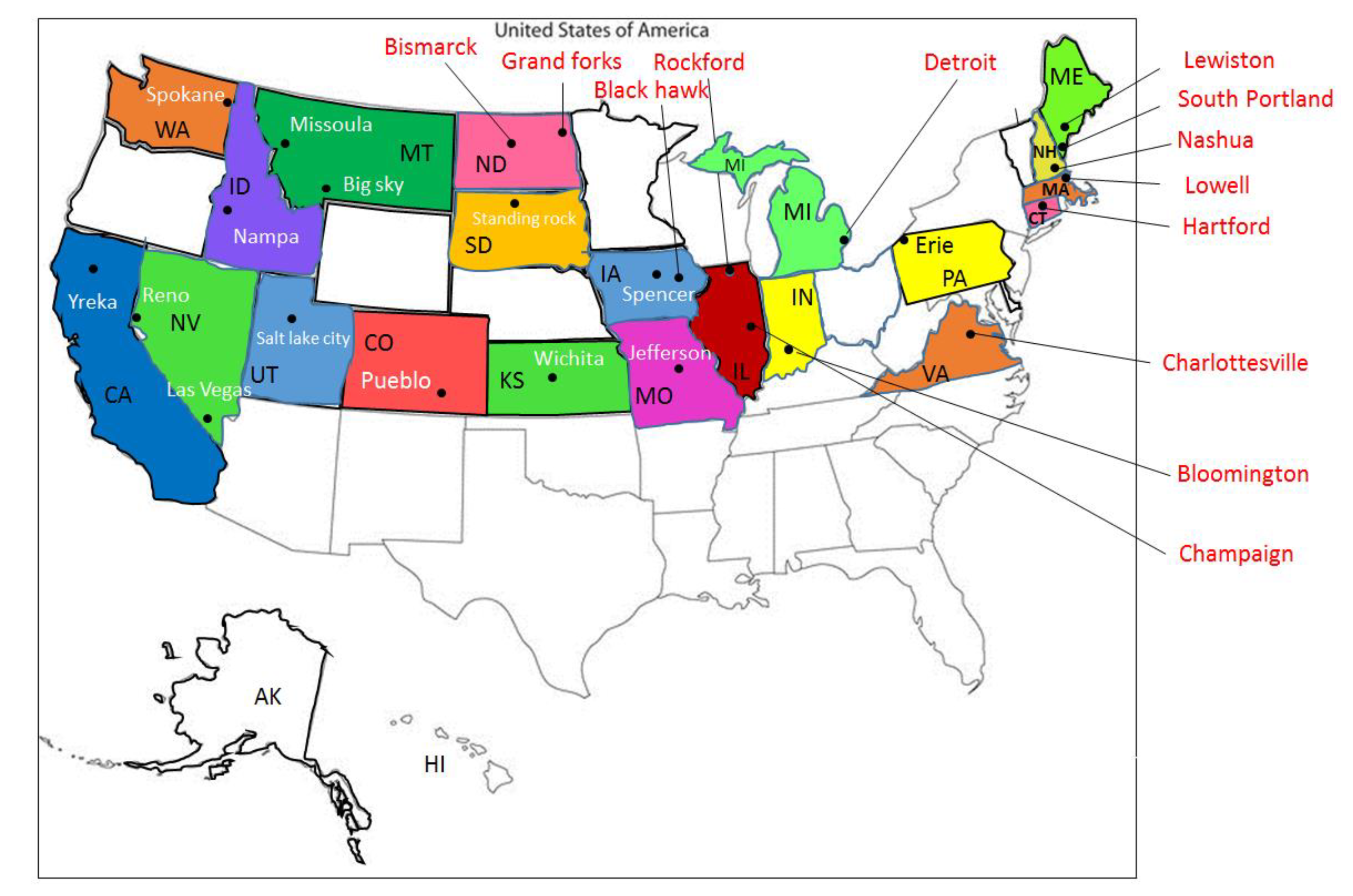
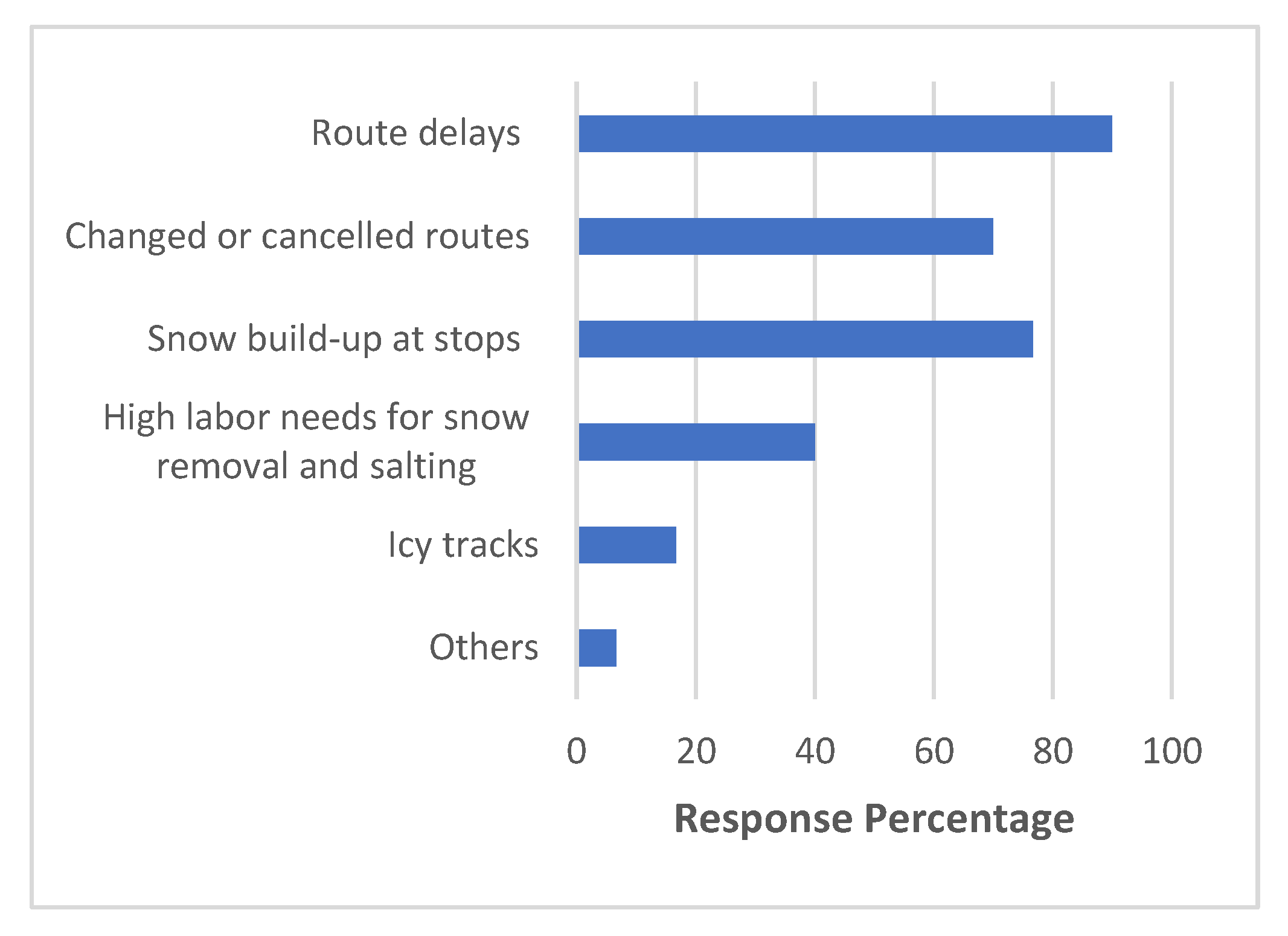
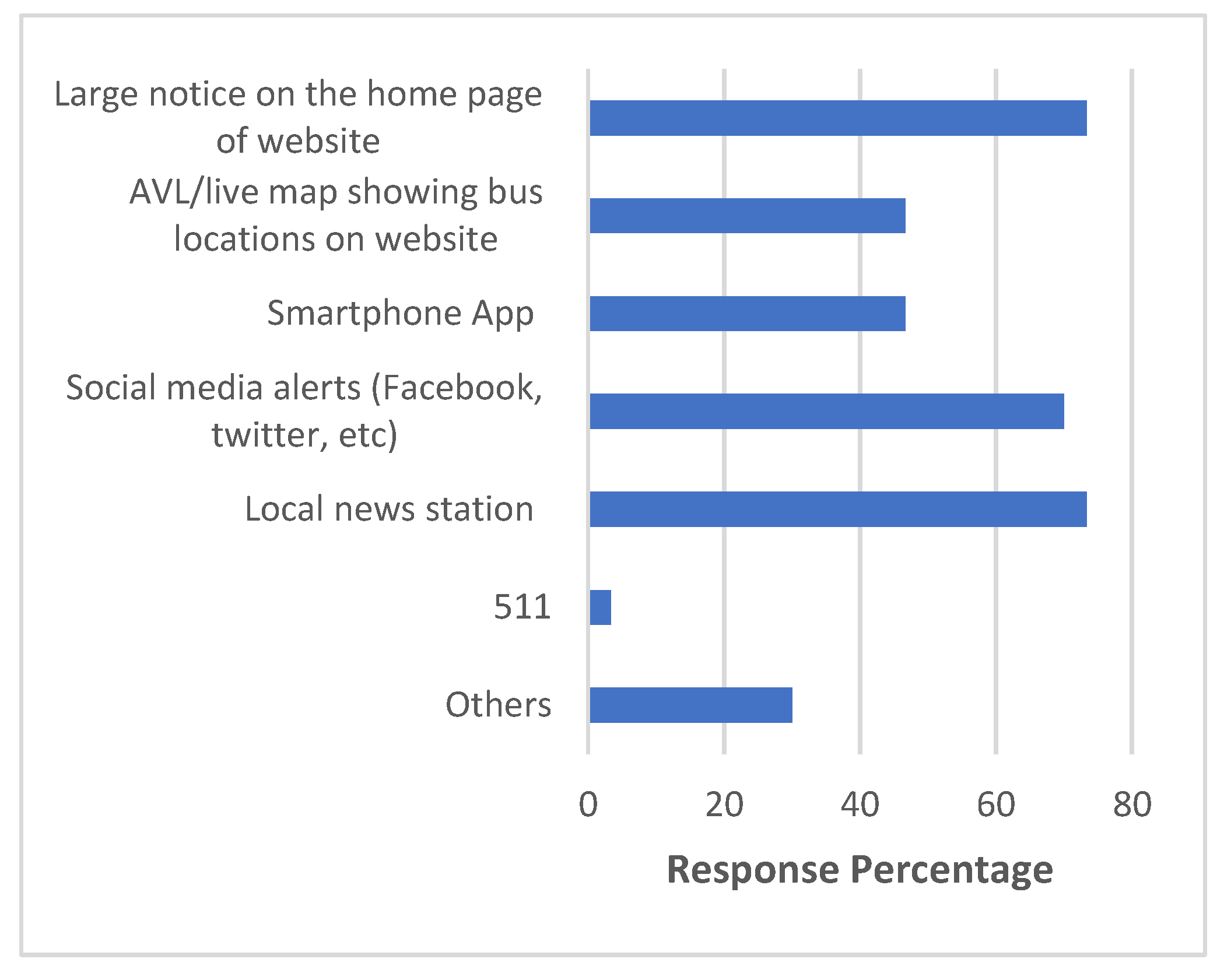

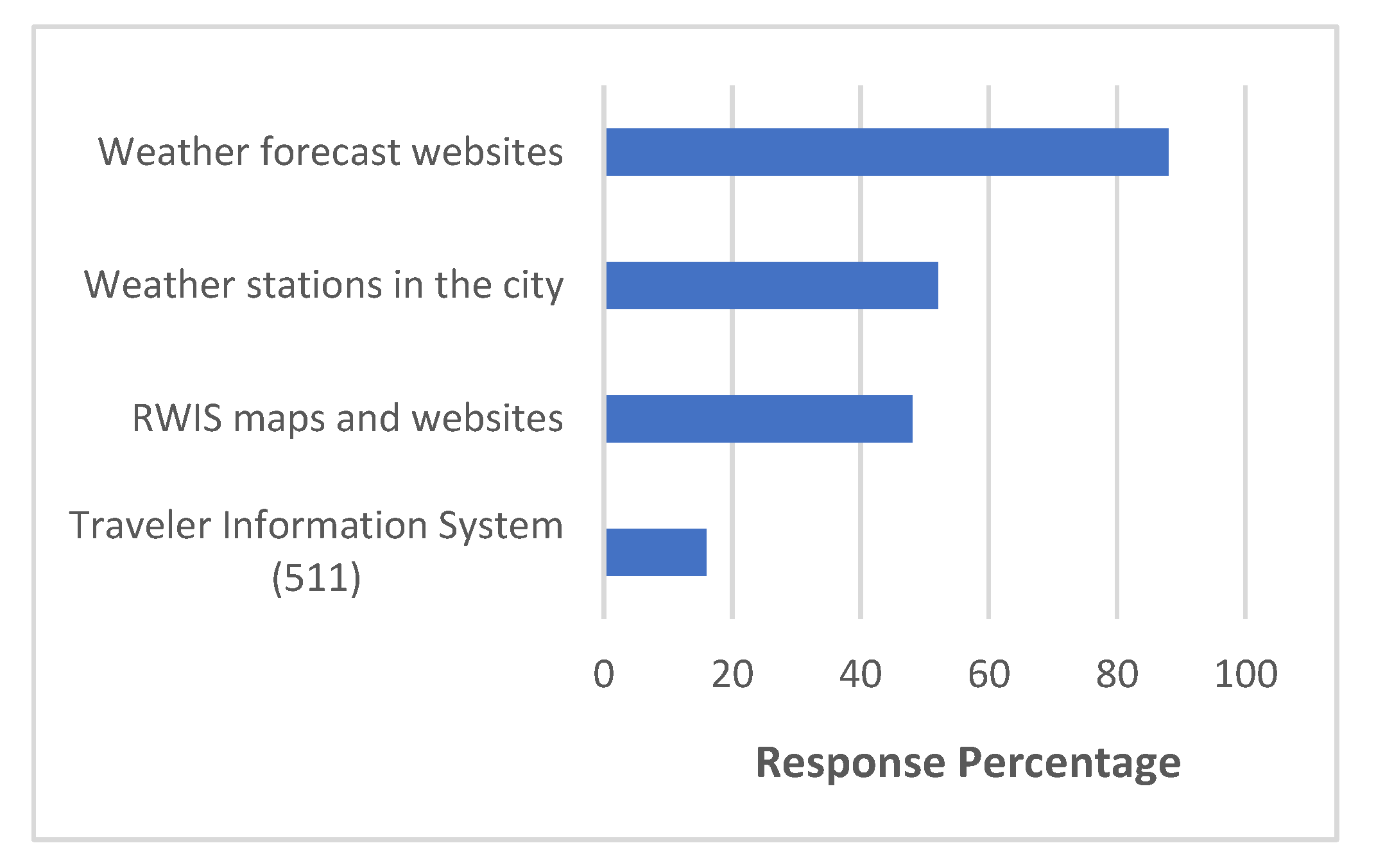
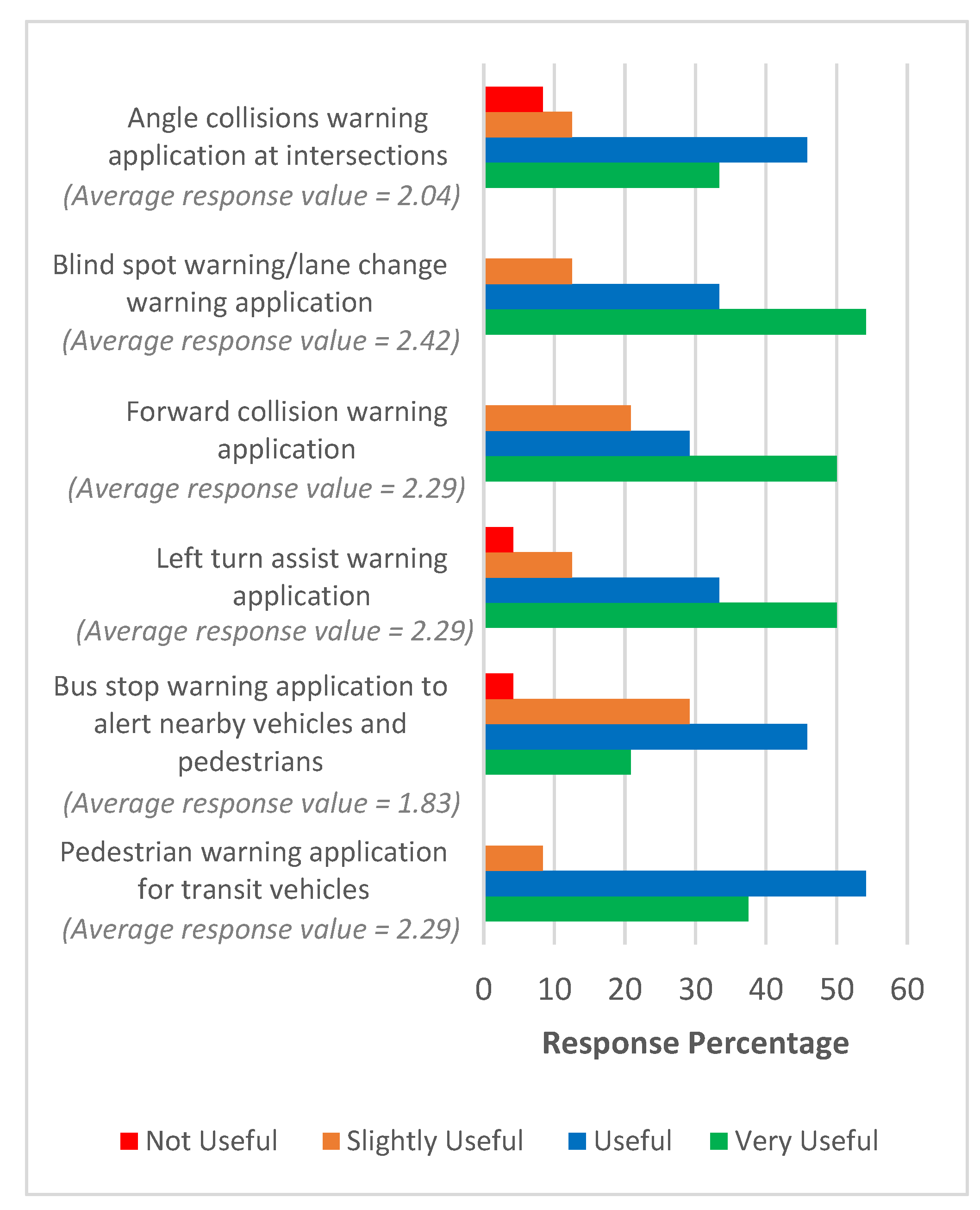
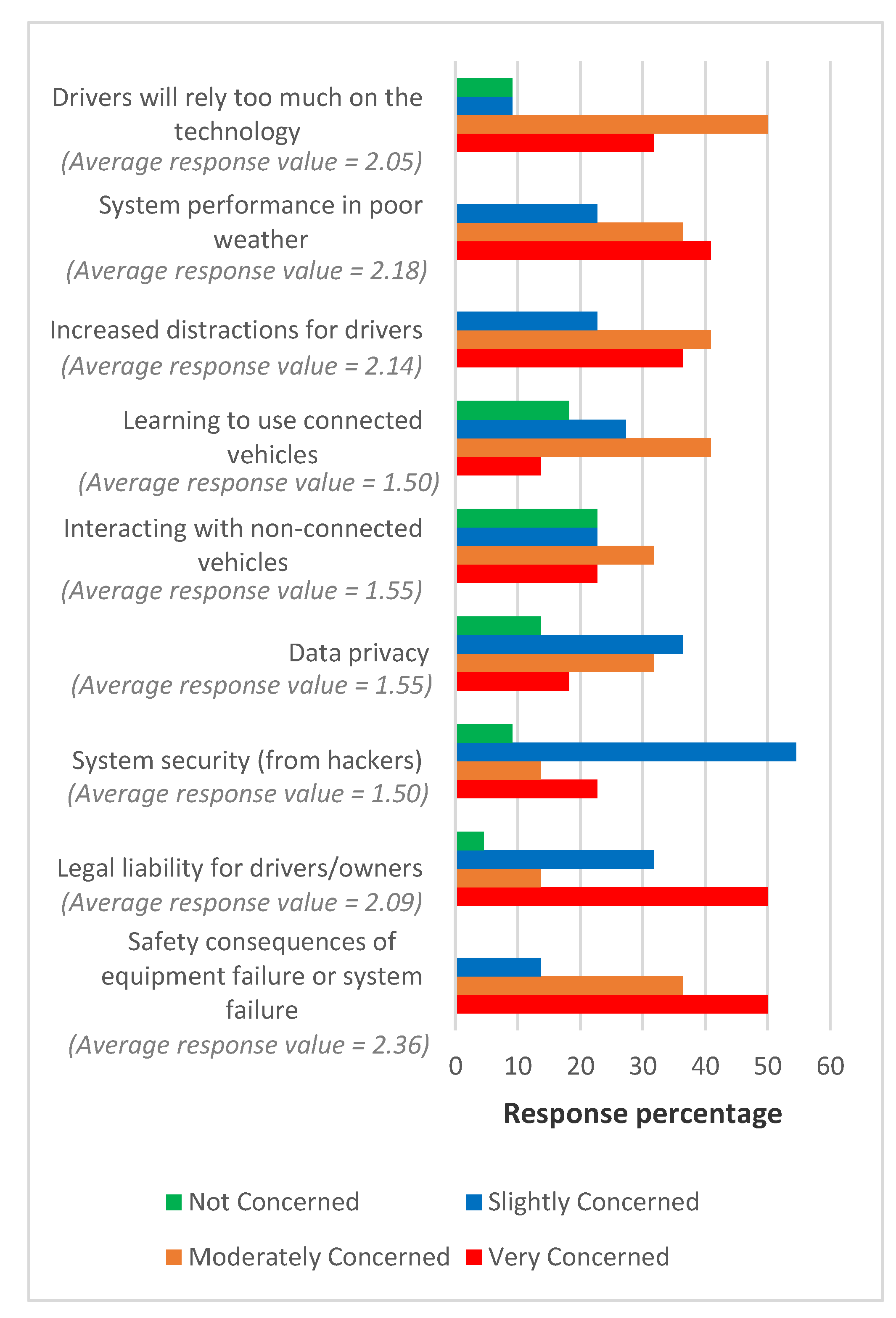
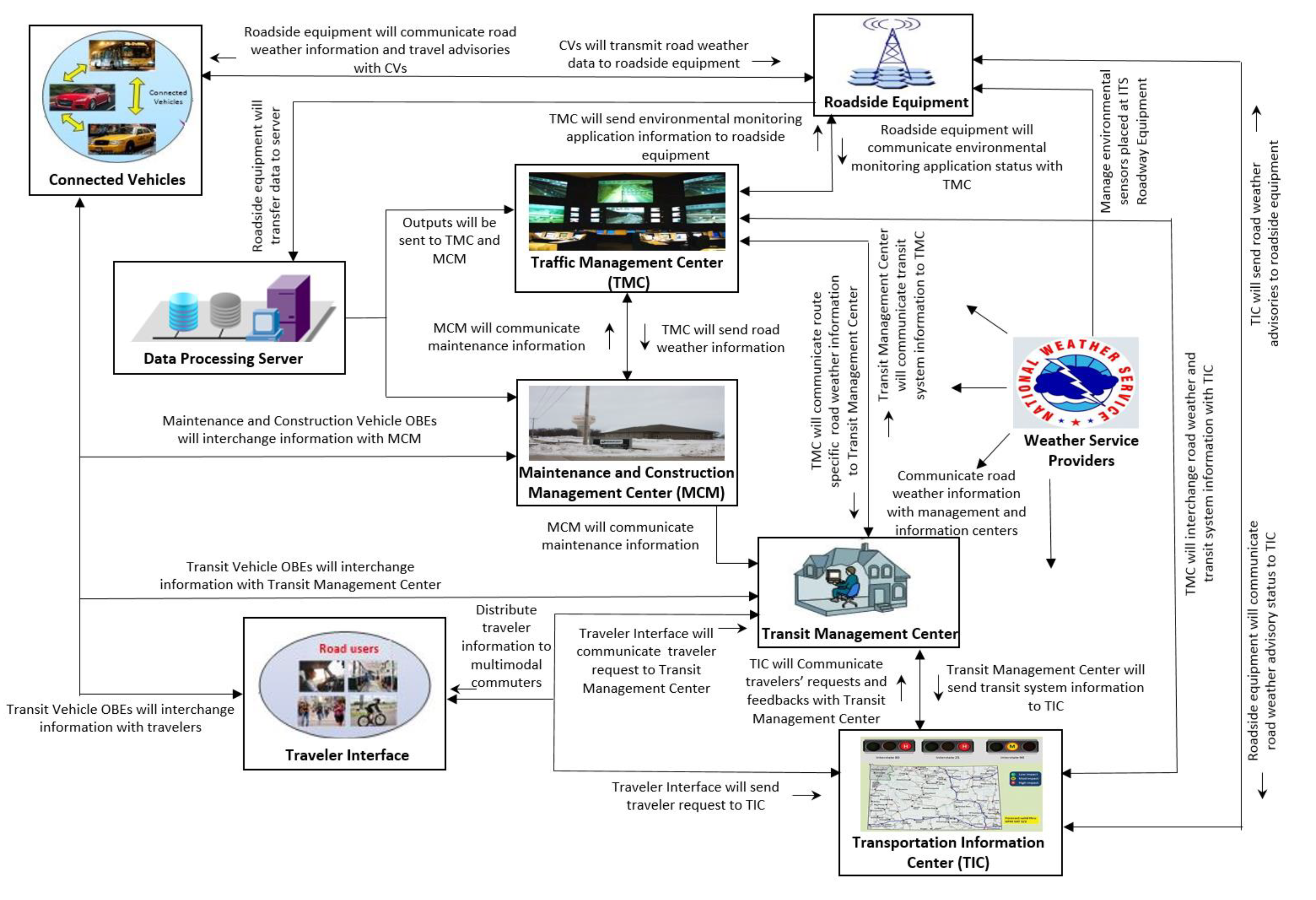

| Survey Questions |
|---|
|
| Subsystem | Information Flow |
|---|---|
| CVs | (i) Will send collected data from road weather sensors, on-board equipment, and GPS to CV Roadside Equipment and to other vehicle OBEs. (ii) Will provide updates on road weather condition to CV drivers. (iii) Maintenance and Construction Vehicle OBEs will send environmental sensor data (e.g., surface temperature, subsurface temperature, treatment status) to Maintenance and Construction Management Center. * (iv) Transit vehicle OBEs will communicate transit vehicle information/status (e.g., schedule, route, performance, vehicle condition) with the Transit Management Center. * (v) Will communicate operational decisions received from the Transit Management Center to transit vehicle operators. * (vi) Will communicate transit vehicle location and motion and transit vehicle information to personal information devices and traveler support equipment. |
| ITS Roadway Equipment | (i) Will send road weather condition information to CV Roadside Equipment. (ii) Will send environmental sensor data to CV Roadside Equipment, and Traffic Management Center, and Maintenance and Construction Management Center after processing at server/cloud platform. |
| CV Roadside Equipment | (i) Will send road weather condition information to ITS Roadway Equipment. (ii) Will send environmental monitoring application status (current operational state and status, and a record of system operation) to the Traffic Management Center. (iii) Will send speed warning application status (i.e., a record of measured vehicle speeds and notifications, alerts, and warning issued) to the Traffic Management Center to ensure if the speed warning application is working properly. (iv) Will send road weather advisory status (i.e., current configuration parameters, a log of issued advisories) to the Transportation Information Center to ensure the road weather advisory application is working properly. (v) Will provide vehicle situational data parameters (parameters used to control data, such as snapshot frequency, filtering criteria, and reporting interval) to vehicle OBE. (vi) Will send road weather advisories, reduced speed notification, and lane or road closure information to vehicle OBEs. (vii) Will send environmental sensor data (e.g., air temperature, exterior light status, wiper status) to the Traffic Management Center and Maintenance and Construction Management Center after processing on a server/cloud platform. |
| Subsystem | Information Flow |
|---|---|
| Traffic Management Center | (i) Will send environmental monitoring information (parameters and threshold) and speed warning monitoring information to CV Roadside Equipment (i.e., sensors). (ii) Will send environmental sensor control data and variable speed limit control data to the ITS Roadway Equipment. (iii) Will share current road condition and surface weather condition data with the Maintenance and Construction Management Center, Transportation Information Center, and Transit Management Center *. |
| Maintenance and Construction Management Center | (i) Will send road weather maintenance information to the Traffic Management Center, Transit Management Center, and Transportation Information Center. |
| Transportation Information Center | (i) Will send road network environmental situation data to the Traffic Management Center and Transit Management Center. (ii) Will send road weather advisories to the CV Roadside Equipment and Vehicle OBEs. * (iii) Will send demand-responsive transit trip requests and trip confirmations to the Transit Management Center. * (iv) Will send interactive traveler information, traveler alerts, and trip plans to personal information devices. * (v) Will send interactive traveler information and traveler alerts to Transit Vehicle OBEs. * (vi) Will communicate travelers’ provided updates on social media sites. * (vii) Will send interactive traveler information to traveler support equipment. |
| Transit Management Center | * (i) Will send transit system data to the Traffic Management Center and Transportation information Center. * (ii) Will send route assignment information, schedules, and transit vehicle operator information to the Transit Vehicle OBEs. * (iii) Will send demand-responsive transit plans, transit and fare schedules, transit incident information, and transit schedule adherence information to the Transportation Information Center. |
| Traveler Interface | * (i) Will send user profiles, trip requests, trip confirmation, and trip feedback to the Transportation Information Center. * (ii) Will send user location and user information to the Transit Vehicle OBEs. * (iii) Will put travel requests and traveler-sourced updates on social media. |
© 2020 by the authors. Licensee MDPI, Basel, Switzerland. This article is an open access article distributed under the terms and conditions of the Creative Commons Attribution (CC BY) license (http://creativecommons.org/licenses/by/4.0/).
Share and Cite
He, Y.; Rahman, M.T.; Akin, M.; Wang, Y.; Dey, K.; Shi, X. Connected Vehicle Technology for Improved Multimodal Winter Travel: Agency Perspective and a Conceptual Exploration. Sustainability 2020, 12, 5071. https://doi.org/10.3390/su12125071
He Y, Rahman MT, Akin M, Wang Y, Dey K, Shi X. Connected Vehicle Technology for Improved Multimodal Winter Travel: Agency Perspective and a Conceptual Exploration. Sustainability. 2020; 12(12):5071. https://doi.org/10.3390/su12125071
Chicago/Turabian StyleHe, Yaqin, Md Tawhidur Rahman, Michelle Akin, Yinhai Wang, Kakan Dey, and Xianming Shi. 2020. "Connected Vehicle Technology for Improved Multimodal Winter Travel: Agency Perspective and a Conceptual Exploration" Sustainability 12, no. 12: 5071. https://doi.org/10.3390/su12125071
APA StyleHe, Y., Rahman, M. T., Akin, M., Wang, Y., Dey, K., & Shi, X. (2020). Connected Vehicle Technology for Improved Multimodal Winter Travel: Agency Perspective and a Conceptual Exploration. Sustainability, 12(12), 5071. https://doi.org/10.3390/su12125071







